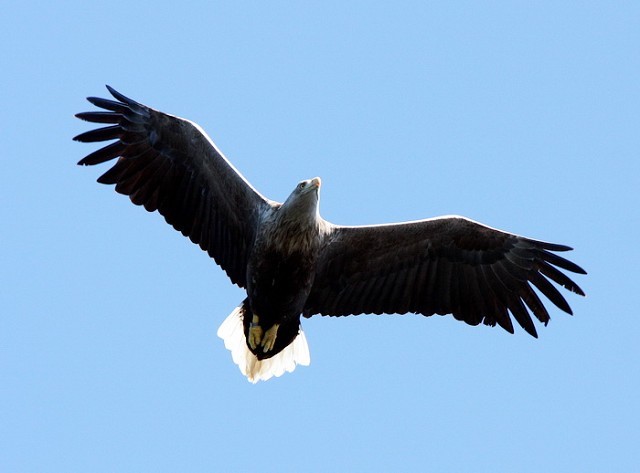Groundbreaking satellite tagging project for Mull White-tailed Eagles
Mull Eagle Watch and RSPB Scotland are delighted to unveil a pioneering satellite tagging project to follow young White-tailed Eagles once they leave the nest. For the first time, people all over the world will be able to get interactive updates on this year's chicks from the Loch Frisa nest online, and see where the birds are. The birds fledged in mid-July and are just beginning to explore their surroundings, and visitors to www.rspb.org.uk/mulleagletracking can be with them every step of the way.

White-tailed Eagle, undisclosed site, Highland (Photo: Dean Eades)
Young White-tailed Eagle chicks roam far and wide, with one bird released on the east coast last summer taking in much of Grampian and Speyside before winging its way over to Loch Frisa itself over the winter, and recently returning to its home patch. The famous Loch Frisa sea eagle project on Mull is a partnership between Forestry Commission Scotland, Scottish Natural Heritage who provide funding, RSPB Scotland, Mull & Iona Community Trust and Strathclyde Police to allow public viewing of a White-tailed Eagle nest - the only live and direct viewing of a nest for the public anywhere in the world. Additional funding for the satellite tagging project will come from Highland Ecology Foundation and Natural Research.
The nest produced two chicks this year: a male called Mara (meaning 'sea' in Gaelic) and a female Breagha ('Bree-ha', meaning 'beautiful' in Gaelic). They fledged in mid-July and are now flying strongly, but visitors to the Loch Frisa hide can still see the birds until the end of August. Now, for the first time, visitors to www.rspb.org.uk/mulleagletracking can follow Mara and Breagha via specially fitted satellite tags, as they spread their wings and explore Scotland.
RSPB Mull Officer Dave Sexton, who will be writing an online blog for the project, said "As technology moves on we're able to learn a lot more about stunning birds like the White-tailed Eagle, and make them more accessible to people at the same time. Although they're our biggest bird of prey and truly massive, it's amazing how elusive they can become as they wander over Scotland - so this research project for the Sea Eagle Project Team will really help us get an idea of how the species' recovery is faring. One of the birds released in Fife last year as part of the east-coast reintroduction travelled right up the east coast to Findhorn, before heading West via Grantown-on-Spey and turning up right here at Loch Frisa earlier this year before heading back to Perth, which gives an idea of how far they roam."

White-tailed Eagle, Portree, Skye, Highland (Photo: Mark Ranner)
The tags were obtained by Roy Dennis, whose Highland Foundation for Wildlife already has expertise in satellite tracking of raptors in Scotland. "This is the first time we've fitted these tags to White-tailed Eagles in the UK" he said. "It's exciting to help the Mull project to follow their young sea eagles because we've learnt so much following Alma - a young Golden Eagle in the Cairngorms. The incredible detail of her daily life has fascinated people and given us new insights. Hopefully similar information from Mara and Breagha will show their journeys in great detail using Google Maps. Will they stay on Mull, will they stay together, where will they wander and where might they seek out places to breed? The more we know, the more likely we are to be able to restore the sea eagle to the UK."
Mull Eagle Watch is a partnership comprised of Forestry Commission Scotland, the Royal Society for the Protection of Birds, Scottish Natural Heritage, Mull & Iona Community Trust and Strathclyde Police.
The parent birds at the Loch Frisa nest, named Frisa and Skye, first nested in 1997 elsewhere on Mull, then moved to Loch Frisa in 1998. This year Frisa (female) is 16 years old and Skye is 14. They have fledged 16 chicks in their history (4 others have died before fledging including last year when they failed with two small chicks when the nest slipped).
The project will also be followed by the BBC's Natural History Unit and will feature in this year's Autumnwatch series with Bill Oddie, Kate Humble, Simon King and Gordon Buchanan.
ESSE (East Scotland Sea Eagles) is the third phase of the Scottish sea eagle re-introduction which began on Rum (owned by the Nature Conservancy Council, now Scottish Natural Heritage) in 1975. Over the next ten years to 1985, a total of 82 eaglets (39 males and 43 females) were imported, under special licence, from nests in northern Norway where the sea eagle population was still expanding. The first wild-bred chicks since extinction were born on Mull in 1985. The second phase saw a further 58 birds released in Wester Ross between 1993 and 1998.

